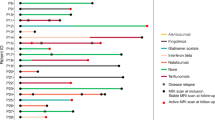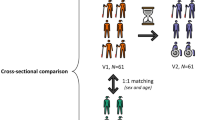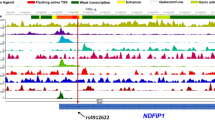Abstract
Several major histocompatibility complex (MHC) alleles have been postulated to influence the susceptibility to multiple sclerosis (MS), as well as its clinical/radiological course. In this longitudinal observation, we further explored the impact of human leukocyte antigen (HLA) class I/II alleles on MS outcomes, and we tested the hypothesis that HLA DRB1*1501 might uncover different strata of MS subjects harboring distinct MHC allele associations with magnetic resonance imaging (MRI) measures. Five hundred eighteen MS patients with two-digit HLA typing and at least one brain MRI were recruited for the study. T2-weighted hyperintense lesion volume (T2LV) and brain parenchymal fraction (BPF) were acquired at each time point. The association between allele count and MRI values was determined using linear regression modeling controlling for age, disease duration and gender. Analyses were also stratified by the presence/absence of HLA DRB1*1501. HLA DRB1*04 was associated with higher T2LV (P=0.006); after stratification, its significance remained only in the presence of HLA DRB1*1501 (P=0.012). The negative effect of HLA DRB1*14 on T2LV was exerted in DRB1*1501-negative group (P=0.012). Longitudinal analysis showed that HLA DRB1*10 was significantly protective on T2LV accrual in the presence of HLA DRB1*1501 (P=0.002). Although the majority of our results did not withstand multiple comparison correction, the differential impact of several HLA alleles in the presence/absence of HLA DRB1*1501 suggests that they may interact in determining the different phenotypic expressions of MS.
This is a preview of subscription content, access via your institution
Access options
Subscribe to this journal
Receive 6 digital issues and online access to articles
$119.00 per year
only $19.83 per issue
Buy this article
- Purchase on Springer Link
- Instant access to full article PDF
Prices may be subject to local taxes which are calculated during checkout
Similar content being viewed by others
References
Lassmann H, Bruck W, Lucchinetti C . Heterogeneity of multiple sclerosis pathogenesis: implications for diagnosis and therapy. Trends Mol Med 2001; 7: 115–121.
Bhat R, Steinman L . Innate and adaptive autoimmunity directed to the central nervous system. Neuron 2009; 64: 123–132.
Hauser SL, Oksenberg JR . The neurobiology of multiple sclerosis: genes, inflammation, and neurodegeneration. Neuron 2006; 52: 61–76.
Fogdell-Hahn A, Ligers A, Gronning M, Hillert J, Olerup O . Multiple sclerosis: a modifying influence of HLA class I genes in an HLA class II associated autoimmune disease. Tissue Antigens 2000; 55: 140–148.
Hafler DA, Compston A, Sawcer S, Lander ES, Daly MJ, De Jager PL et al. Risk alleles for multiple sclerosis identified by a genomewide study. N Engl J Med 2007; 357: 851–862.
Olerup O, Hillert J . HLA class II-associated genetic susceptibility in multiple sclerosis: a critical evaluation. Tissue Antigens 1991; 38: 1–15.
Sawcer S, Ban M, Maranian M, Yeo TW, Compston A, Kirby A et al. A high-density screen for linkage in multiple sclerosis. Am J Hum Genet 2005; 77: 454–467.
Rioux JD, Goyette P, Vyse TJ, Hammarstrom L, Fernando MM, Green T et al. Mapping of multiple susceptibility variants within the MHC region for 7 immune-mediated diseases. Proc Natl Acad Sci USA 2009; 106: 18680–18685.
Smestad C, Brynedal B, Jonasdottir G, Lorentzen AR, Masterman T, Akesson E et al. The impact of HLA-A and -DRB1 on age at onset, disease course and severity in Scandinavian multiple sclerosis patients. Eur J Neurol 2007; 14: 835–840.
Ramagopalan SV, Deluca GC, Degenhardt A, Ebers GC . The genetics of clinical outcome in multiple sclerosis. J Neuroimmunol 2008; 201: 183–199.
Vasconcelos CC, Fernandez O, Leyva L, Thuler LC, Alvarenga RM . Does the DRB1*1501 allele confer more severe and faster progression in primary progressive multiple sclerosis patients? HLA in primary progressive multiple sclerosis. J Neuroimmunol 2009; 214: 101–103.
Zivadinov R, Uxa L, Zacchi T, Nasuelli D, Ukmar M, Furlan C et al. HLA genotypes and disease severity assessed by magnetic resonance imaging findings in patients with multiple sclerosis. J Neurol 2003; 250: 1099–1106.
Okuda DT, Srinivasan R, Oksenberg JR, Goodin DS, Baranzini SE, Beheshtian A et al. Genotype–phenotype correlations in multiple sclerosis: HLA genes influence disease severity inferred by 1HMR spectroscopy and MRI measures. Brain 2009; 132: 250–259.
Sombekke MH, Lukas C, Crusius JB, Tejedor D, Killestein J, Arteta D et al. HLA-DRB1*1501 and spinal cord magnetic resonance imaging lesions in multiple sclerosis. Arch Neurol 2009; 66: 1531–1536.
Zivadinov R, Uxa L, Bratina A, Bosco A, Srinivasaraghavan B, Minagar A et al. HLA-DRB1*1501, -DQB1*0301, -DQB1*0302, -DQB1*0602, and -DQB1*0603 alleles are associated with more severe disease outcome on MRI in patients with multiple sclerosis. Int Rev Neurobiol 2007; 79: 521–535.
Healy BC, Liguori M, Tran D, Chitnis D, Glanz BI, Wolfish C et al. HLA B*44: protective effects in MS susceptibility and MRI outcome measures. Neurology 2010; 75: 634–640.
Zivadinov R, Weinstock-Guttman B, Zorzon M, Uxa L, Serafin M, Bosco A et al. Gene–environment interactions between HLA B7/A2, EBV antibodies are associated with MRI injury in multiple sclerosis. J Neuroimmunol 2009; 209: 123–130.
Wu JS, James I, Qiu W, Castley A, Christiansen FT, Carroll WM et al. HLA-DRB1 allele heterogeneity influences multiple sclerosis severity as well as risk in Western Australia. J Neuroimmunol 2010; 219: 109–113.
Johnston DT, Schroeder HW . B-cell numbers in the blood of patients with non-HLA*B8 or non-HLA*B44 common variable immunodeficiency. Ann Allergy Asthma Immunol 2007; 98: 163–167.
Ovsyannikova IG, Jacobson RM, Vierkant RA, Pankratz VS, Poland GA . HLA supertypes and immune responses to measles–mumps–rubella viral vaccine: findings and implications for vaccine design. Vaccine 2007; 25: 3090–3100.
Silva-Ramirez B, Vargas-Alarcon G, Granados J, Burgos-Vargas R . HLA antigens and juvenile onset spondyloarthritides: negative association with non-B27 alleles. Clin Exp Rheumatol 2005; 23: 721–723.
DeLuca GC, Ramagopalan SV, Herrera BM, Dyment DA, Lincoln MR, Montpetit A et al. An extremes of outcome strategy provides evidence that multiple sclerosis severity is determined by alleles at the HLA-DRB1 locus. Proc Natl Acad Sci USA 2007; 104: 20896–20901.
Ramagopalan SV, Morris AP, Dyment DA, Herrera BM, DeLuca GC, Lincoln MR et al. The inheritance of resistance alleles in multiple sclerosis. PLoS Genet 2007; 3: 1607–1613.
Bergamaschi L, Leone MA, Fasano ME, Guerini FR, Ferrante D, Bolognesi E et al. HLA-class I markers and multiple sclerosis susceptibility in the Italian population. Genes Immun 2010; 11: 173–180.
Chao MJ, Barnardo MC, Lincoln MR, Ramagopalan SV, Herrera BM, Dyment DA et al. HLA class I alleles tag HLA-DRB1*1501 haplotypes for differential risk in multiple sclerosis susceptibility. Proc Natl Acad Sci USA 2008; 105: 13069–13074.
Gregersen JW, Kranc KR, Ke X, Svendsen P, Madsen LS, Thomsen AR et al. Functional epistasis on a common MHC haplotype associated with multiple sclerosis. Nature 2006; 443: 574–577.
Ramagopalan SV, Ebers GC . Epistasis: multiple sclerosis and the major histocompatibility complex. Neurology 2009; 72: 566–567.
Traherne JA . Human MHC architecture and evolution: implications for disease association studies. Int J Immunogenet 2008; 35: 179–192.
Comabella M, Fernandez-Arquero M, Rio J, Guinea A, Fernandez M, Cenit MC et al. HLA class I and II alleles and response to treatment with interferon-beta in relapsing-remitting multiple sclerosis. J Neuroimmunol 2009; 210: 116–119.
De Jager PL, Simon KC, Munger KL, Rioux JD, Hafler DA, Ascherio A . Integrating risk factors: HLA-DRB1*1501 and Epstein–Barr virus in multiple sclerosis. Neurology 2008; 70: 1113–1118.
Hoffmann S, Cepok S, Grummel V, Lehmann-Horn K, Hackermuller J, Stadler PF et al. HLA-DRB1*0401 and HLA-DRB1*0408 are strongly associated with the development of antibodies against interferon-beta therapy in multiple sclerosis. Am J Hum Genet 2008; 83: 219–227.
McDonald WI, Compston A, Edan G, Goodkin D, Hartung HP, Lublin FD et al. Recommended diagnostic criteria for multiple sclerosis: guidelines from the International Panel on the diagnosis of multiple sclerosis. Ann Neurol 2001; 50: 121–127.
Polman CH, Reingold SC, Edan G, Filippi M, Hartung HP, Kappos L et al. Diagnostic criteria for multiple sclerosis: 2005 revisions to the ‘McDonald Criteria’. Ann Neurol 2005; 58: 840–846.
Montalban X, Tintore M, Swanton J, Barkhof F, Fazekas F, Filippi M et al. MRI criteria for MS in patients with clinically isolated syndromes. Neurology 2009; 74: 427–434.
Kurtzke JF . Rating neurologic impairment in multiple sclerosis: an expanded disability status scale (EDSS). Neurology 1983; 33: 1444–1452.
Roxburgh RH, Seaman SR, Masterman T, Hensiek AE, Sawcer SJ, Vukusic S et al. Multiple Sclerosis Severity Score: using disability and disease duration to rate disease severity. Neurology 2005; 64: 1144–1151.
Glanz BI, Holland CM, Gauthier SA, Amunwa EL, Liptak Z, Houtchens MK et al. Cognitive dysfunction in patients with clinically isolated syndromes or newly diagnosed multiple sclerosis. Mult Scler 2007; 13: 1004–1010.
Wei X, Warfield SK, Zou KH, Wu Y, Li X, Guimond A et al. Quantitative analysis of MRI signal abnormalities of brain white matter with high reproducibility and accuracy. J Magn Reson Imaging 2002; 15: 203–209.
Liu L, Meier D, Polgar-Turcsanyi M, Karkocha P, Bakshi R, Guttmann CR . Multiple sclerosis medical image analysis and information management. J Neuroimaging 2005; 15: 103S–107S.
Acknowledgements
We thank the many experts at the Center for Neurological Imaging, who participated in image analysis and quality control of data presented in this work. In particular, we would like to thank Drs Zsuzsanna Liptak, Svetlana Egorova, Yang Duan and Annika Berger.
Author information
Authors and Affiliations
Corresponding author
Ethics declarations
Competing interests
The authors declare no conflict of interest.
Additional information
Supplementary Information accompanies the paper on Genes and Immunity website
Supplementary information
Rights and permissions
About this article
Cite this article
Liguori, M., Healy, B., Glanz, B. et al. HLA (A-B-C and -DRB1) alleles and brain MRI changes in multiple sclerosis: a longitudinal study. Genes Immun 12, 183–190 (2011). https://doi.org/10.1038/gene.2010.58
Received:
Revised:
Accepted:
Published:
Issue Date:
DOI: https://doi.org/10.1038/gene.2010.58



